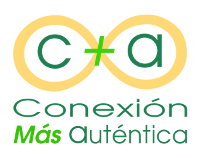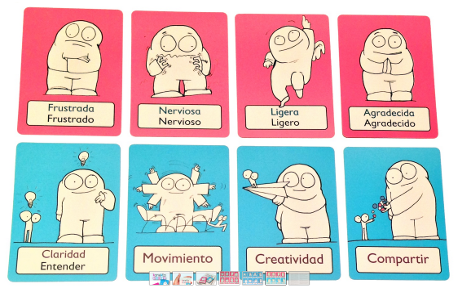Label: Interpersonal communication
Letters feelings and needs “EASY Konekta” de Simple Cat
6 February 2015.
Tags: CNV, Interpersonal communication, Education, For boys and girls, For parents
Nonviolent Communication It is a very profound tool, which should be developed by all means and through all possible channels. Those who have done workshops with me have seen the profusion of resources use (visual, space…), among other letters I-crafted, and I use over several years.
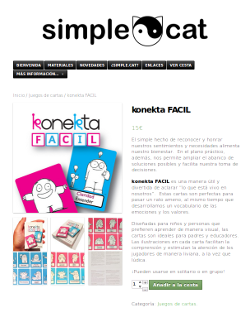 I was pleased a lot with the recent appearance of the letters “EASY Konekta”, a resource useful to accompany the processes of people who rely on the visual, especially children. In Simple Cat, a small company that is striving to bring and create teaching materials for training in Nonviolent Communication in Spain, They have chosen to launch these cards own design.
I was pleased a lot with the recent appearance of the letters “EASY Konekta”, a resource useful to accompany the processes of people who rely on the visual, especially children. In Simple Cat, a small company that is striving to bring and create teaching materials for training in Nonviolent Communication in Spain, They have chosen to launch these cards own design.
I just received letters “EASY Konekta” and I liked many aspects. On the one hand, the design, with simple drawings that make the cards very affordable, with pink background for the feelings and needs blue background (a code and universalized in the community of Nonviolent Communication by NVC Dance Floors).
On the other hand, the way they caring words: feelings are masculine and feminine, so that everyone can feel included us easily; and needs are often expressed in two complementary ways, so that the person can explore what is the word that fits you best.
Further, add a number of proposed use (Game suggestions), adapted from other sources with your permission, including the famous “Póker CNV”, that I use in deepening workshops.
From here my congratulations to the team Simple Cat this new resource. I'm looking forward to my next workshop try and see what they think those involved. Meanwhile you can explore more on the cards in the página web and you can buy them online if you're interested.
I trust that you are practical and easy to deepen Nonviolent Communication.
Xavier
Celebrating 80 anniversary of Marshall Rosenberg, creator of Nonviolent Communication
20 October 2014.
Tags: CNV, Interpersonal communication, CI Spirals, Experiences, Webs
Last 6 October Marshall Rosenberg, the creator of the Nonviolent Communication, has fulfilled eighty and who have experienced the benefits of their work we are celebrating.
Marshall B. Rosenberg He was born 6 October 1934 in Canton, Ohio (U.S), and the family moved in 1943 a Detroit, Michigan, shortly before the race riots of that year. Marshall tells how the experience of violence marked him. Also experienced violence at school, to being identified as a Jew by his surname. As he himself, he discovered that there are people who can enjoy harm. And at the same time, He could see how other people were able to move with compassion for extremely tough situations (her grandmother, During the crisis was able to feed people in the street; or his uncle, I was able to feed and heal and elderly grandmother).
Later studied psychology and obtained his doctorate with Carl Rogers 1961, definitely qualifying itself as a clinical psychologist in 1966. However, the focus of clinical psychology did not satisfy him, with the emphasis on labels and diagnoses. He continued researching and forming (It was also formed in Focusing, and made it recommends in its advanced training), and at the end he created the process Nonviolent Communication as we know it.
Since the eighties has worked internationally both for mediation in serious conflicts and to develop conflict resolution skills smaller in our daily lives, conflicts with others and internal conflicts. A few years ago it has retired, after making hundreds of formations in the world and have founded International Center for Nonviolent Communication (Center for NonViolent Communication) to spread this process as transformer. You can read more about his life and where he has worked in the Website of the International Center for Nonviolent Communication (Center for NonViolent Communication).
I had the pleasure of formarme with him, with his wife Valentina and other trainers in an Intensive International Training (International Intensive Training) nine days in Switzerland in August 2008, and I could receive warmth and how he encouraged me to try to convey my understanding of Nonviolent Communication to children and people who are in contact with them. Much of my work has since been inspired by what I learned from him, both to create a More Authentic Connection in the lives of all people (including mine), and in the lives of children, and adolescents with whom they come in contact, and people who are around (especially through Spiral Consulting Children, in line Interpersonal communication). In this training we talked Certification, and although the end is a way I have not followed, I feel part of the movement of Nonviolent Communication and continue working with the Association for Nonviolent Communication here in Spain and other groups and learning practices.
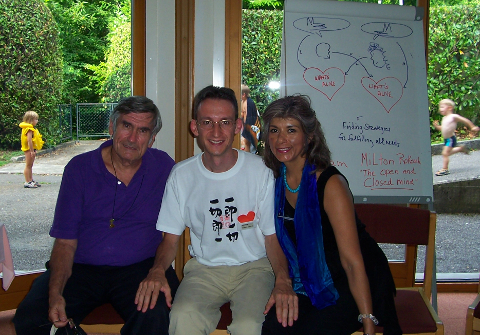
At that time we took this photo, coincidences of fate, portrays in Marshall, Valentina and me with two children and no recognizable girl, as symbolizing specially working with children that took place with the inspiration of Marshall and Nonviolent Communication.
From here I send my thanks and tribute. Thank you, Marshall!
With deep gratitude I send my celebrative homage. Thank you, Marshall!
Xavier
NVC Dance Floors: practice Nonviolent Communication in a holistic manner
25 September 2014.
Tags: CNV, Interpersonal communication, Education, In English, My Classifieds, For Teens, For boys and girls, For parents, Psychotherapy, Therapy, Texts CNV, Videos
The NVC Dance Floors have already appeared in the version in Castilian, in which I have worked, and are also available videos subtitled in Spanish.
Bridget Belgrave and Gina Lawrie, Certified trainers for the Center for Nonviolent Communication (Center for NonViolent Communication, CNVC), years they created a great tool to teach and practice Nonviolent Communication (CNV). As they themselves have in submission, the NVC Dance Floors (NVC Dance Floors) They emerged through a series of steps to facilitate the practice of Nonviolent Communication with a spatial maps that allow use body size to work the emotional dimension, the way you see in this video:
In summer 2009 formarme had the pleasure to meet with Gina and Bridget, From there already work resumed translation and adaptation to the Castilian, an effort in which we have helped many people and I have coordinated for a while. So it is a pleasure to spread a simple tool and yet so deep, finally in Spanish, in which we care to include the largest possible number of Spanish version.
My experience is that the NVC Dance Floors the people can practice with just a few initial knowledge of Nonviolent Communication (In fact I sometimes use in introductory workshops). Even people who do not know the process of Nonviolent Communication itself (children, and adolescents, therapy clients) They can easily cross it with help from someone more experienced.
The NVC Dance Floors combine the visual, corporal and language, so that experience occurs through more channels and experience is deeper. And there are nine “dances” different, with names such as “The Dance of the 13 Steps”, “Integration and Dance Connection”, “The Dance of Anger / Rage, Shame and Depression”, “Dance of Yes and No”, The “Transform the pain of unmet needs in the Beauty Needs”.
Further, in 2013 they released some videos that explain three of these dances, in a neat edition that includes Spanish subtitles.
If you want to buy the dance floor CNV in different formats (as a download in PDF, on paper, plasticized version…) and DVDs to learn them at home or in group practice, you can visit its online store, Life Resources.
And if you want to count on me to try the dance floor in one session or in specific workshops, I will be happy to accompany.
I hope you like.
Xavier
Article “Crossing Focusing and Nonviolent Communication” in The Folio 2014 (The Focusing Institute)
25 June 2014.
Tags: Agenda actual, CNV, Interpersonal communication, Focusing, In English, My Classifieds, Texts CNV, Textos Focusing
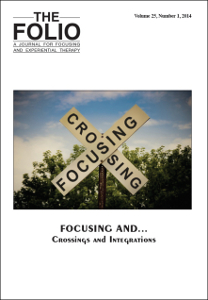 I am happy to share this article that The Focusing Institute has published in The Folio. A Journal for Focusing and Experiential Therapy, its academic journal, in its volume 25 of 2014. My paper “Crossing Focusing and Nonviolent Communication. Reflecting for deeper implications“ appeared at the beginning of 2014 and it has just been published digitally with free access and PDF format in the official website of The Folio.
I am happy to share this article that The Focusing Institute has published in The Folio. A Journal for Focusing and Experiential Therapy, its academic journal, in its volume 25 of 2014. My paper “Crossing Focusing and Nonviolent Communication. Reflecting for deeper implications“ appeared at the beginning of 2014 and it has just been published digitally with free access and PDF format in the official website of The Folio.
[Update February 9th 2017] Download the Japanese version of the article, “The intersection of the focusing and the non-violent communication - towards the deeper implications tell-back”, and read the story of its translation (in Spanish) by Madoka Kawahara (Kawahara circle) y Mako Hikasa (Mako Hikasa). thank you very much!
I leave here the abstract:
ABSTRACT
Both Focusing and Nonviolent Communication (NVC) are based on the idea that people get insights and their inner processes get carried forward when some of their words are reflected. Reflection enhances connection both with oneself and with the companion. And reflection brings deeper implications, as implied aspects come into existence and become conscious.
However, Focusing and Nonviolent Communication put the stress on reflecting different aspects of the original communication. Focusing follows felt senses in the body as a new way to create new meaning. Nonviolent Communication tries to find the universal needs that are at the core of every human action. Focusing and Nonviolent Communication have been crossed in different ways (a short revision of some crossings is explored in this paper). Focusing can be enriched by introducing a new awareness for needs, especially when Asking. And Nonviolent Communication can be enhanced by a new sensitiveness to the original expressions of the person –not just trying to “translate” everything, but also valuing habitual language as metaphors.
When both processes are combined and the companion/therapist reflects aspects of both levels of awareness, the person achieves relevant results as deep implications emerge.
Keywords: Focusing, Nonviolent Communication (NVC), Empathy, Reflect, Crossing.
For Spanish speakers, Go to this post in Spanish.
I hope that you will enjoy it and I will love reading your comments,
Xavier
Artículo “Cómo combinar Focusing y Comunicación NoViolenta” en el Folio 2014 de The Focusing Institute
25 June 2014.
Tags: Agenda actual, CNV, Interpersonal communication, Focusing, My Classifieds, Texts CNV, Textos Focusing
 With great joy I share this article that I published The Focusing Institute (International Focusing Institute based in New York) volume 25 corresponding to 2014 of The Folio. A Journal for Focusing and Experiential Therapy, official academic journal. Appeared in the paper version earlier 2014, my article “Crossing Focusing and Nonviolent Communication. Reflecting for deeper implications“ It has just been published in English in free access in PDF on the official website The Folio.
With great joy I share this article that I published The Focusing Institute (International Focusing Institute based in New York) volume 25 corresponding to 2014 of The Folio. A Journal for Focusing and Experiential Therapy, official academic journal. Appeared in the paper version earlier 2014, my article “Crossing Focusing and Nonviolent Communication. Reflecting for deeper implications“ It has just been published in English in free access in PDF on the official website The Folio.
[update 9 February 2017] Download the Japanese version of the article “The intersection of the focusing and the non-violent communication - towards the deeper implications tell-back” and see the translation history.
And I also leave the initial summary:
SUMMARY
Focusing as both Nonviolent Communication (CNV) They are based on the idea that people get insights and our processes are carried forward when we reflect some of our words. The reflection power connection of the person with herself and who accompanies. And the reflection carries deeper implications while the implicit aspects open to their own existence and are recognized consciously.
However, Focusing and Nonviolent Communication They emphasize reflect different aspects of the original communication. Focusing follows heartfelt feelings in the body as a new way to create new meaning. Nonviolent Communication tries to find the needs universal human that underlie every human action. Focusing and Nonviolent Communication They have combined (crossed) in different ways (a brief review of some combinations are explored in this article). Focusing can be enriched by introducing a new awareness of the needs, especially in passing Ask. And the Nonviolent Communication You can promote a new sensitivity to the original terms of person-not just trying to "translate" all, but also valuing the common language as a set of metaphors.
When the two processes are combined and when the listener as a coach or therapist reflects aspects of both levels of consciousness, the person achieves relevant results to emerge profound implications.
Keywords: Focusing, Nonviolent Communication (NVC) / Nonviolent Communication (CNV), Empathy, Reflect, Crossing/Cross / Combine.
For English speakers, go to this post in English.
I hope you enjoy it and be happy to read your comments,
Xavier
Upgrade 26 September 2014:
I had the honor of the Castilian version of my article appearing in the page in Spanish Focusing Institute in New York (The Focusing Institute). Thank you! Thank you very much!
Upgrade 9 February 2017:
Very grateful for the Japanese translation of Madoka Kawahara (Kawahara circle) y Mako Hikasa (Mako Hikasa). thank you very much! Aquí está la translation history.
Book “How to talk so your kids will listen and listen so your kids will talk” Adele Faber and Elaine Mazlish
20 May 2014.
Tags: Interpersonal communication, Education, For parents, Other Texts
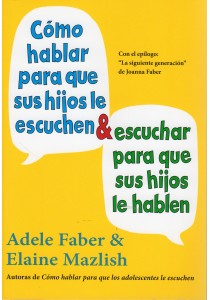 A few days ago I commented in a blog post by Spiral Consulting for Children, where I work on interpersonal communication issues for families and professionals who work with children, and adolescents, that sometimes a workshop to improve communication in the family or in the classroom serves to arouse interest, and aside from the insights gained and the tools learned, many people ask for more material to lean on. I like to recommend book Adele Faber y Elaine Mazlish (trainers and mothers) with the suggestive title How to talk so your kids will listen and listen so your kids will talk, a classic of communication with boys and girls that appeared in 1980. For years it has become a benchmark of positive parenting: empathetic and validating listening while setting limits and reaching satisfactory agreements for all parties involved.
A few days ago I commented in a blog post by Spiral Consulting for Children, where I work on interpersonal communication issues for families and professionals who work with children, and adolescents, that sometimes a workshop to improve communication in the family or in the classroom serves to arouse interest, and aside from the insights gained and the tools learned, many people ask for more material to lean on. I like to recommend book Adele Faber y Elaine Mazlish (trainers and mothers) with the suggestive title How to talk so your kids will listen and listen so your kids will talk, a classic of communication with boys and girls that appeared in 1980. For years it has become a benchmark of positive parenting: empathetic and validating listening while setting limits and reaching satisfactory agreements for all parties involved.
Inspired by the workshops that both authors carried out, The book is structured around the following contents: Chapter 1. How to help children deal with their feelings. Chapter 2. How to foster collaboration. Chapter 3. Alternatives to punishment. Chapter 4. How to stimulate autonomy. Chapter 5. the praise. Chapter 6. How to escape typecasting. Chapter 7. Recapitulemos. Further, in the latest edition of 2013 of Editorial Medici includes a look back from the authors to learning and experiences over more than thirty years and a touching afterword by Joanna Faber, with her experience as the daughter of the author Adele Faber and her encounter with her own motherhood.
From a positive view of the human being and human relations, the text is based on basic reasoning and many examples, some illustrated with vignettes that are like life itself, and continually offers ideas to be put into practice with the boys and girls around us. Although it is initially geared towards families, It can also be used in the educational and social field (although the authors have other specific books for the subject of studies).
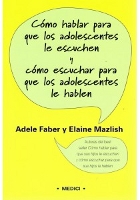 And if your sons and daughters (or the students you work with) they are older, you can also look at the book by the same authors How to talk so teens will listen and how to listen so teens will talk to you, offering some different ideas (appropriate for when they are older) and suggestions always useful, that will probably make you smile.
And if your sons and daughters (or the students you work with) they are older, you can also look at the book by the same authors How to talk so teens will listen and how to listen so teens will talk to you, offering some different ideas (appropriate for when they are older) and suggestions always useful, that will probably make you smile.
I wish you a happy reading, and that you enjoy exploring new forms of communication.
Xavier
